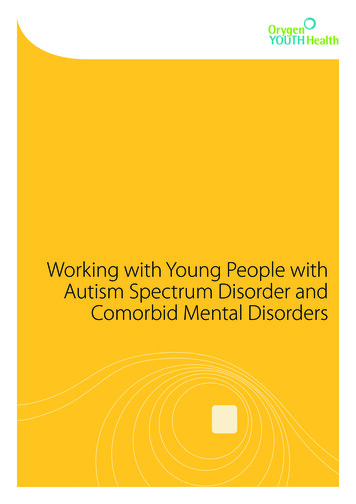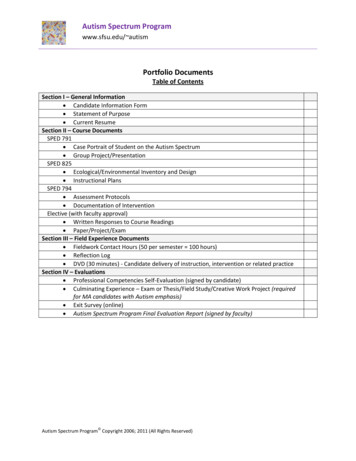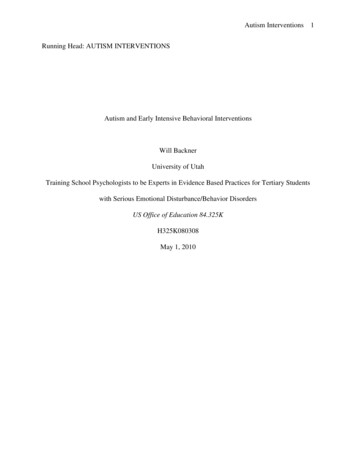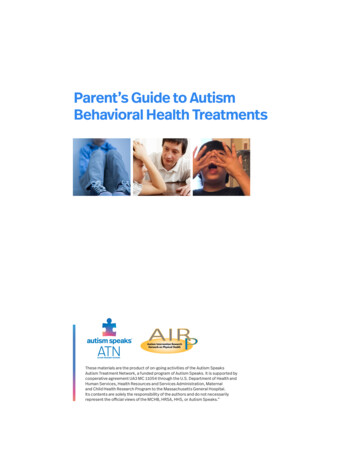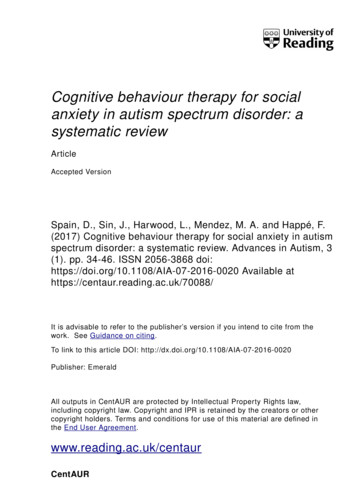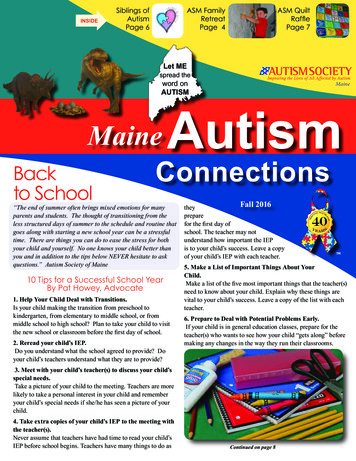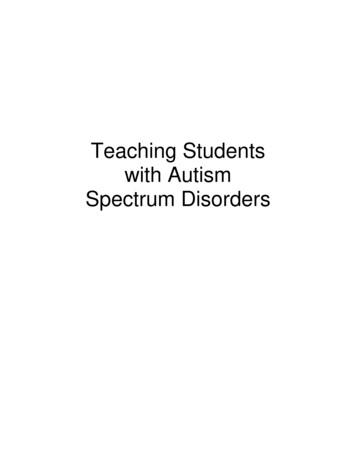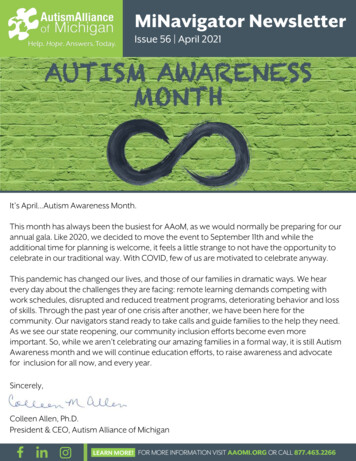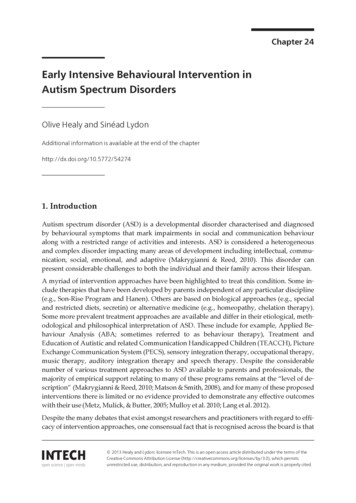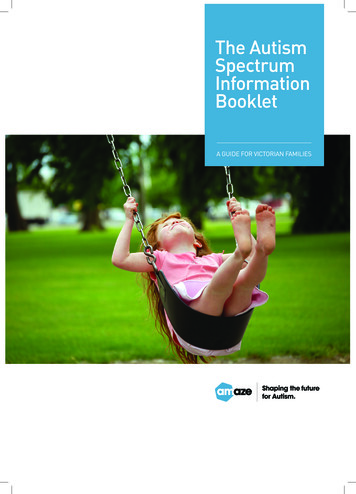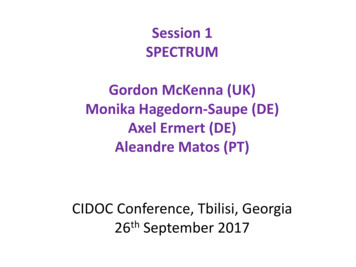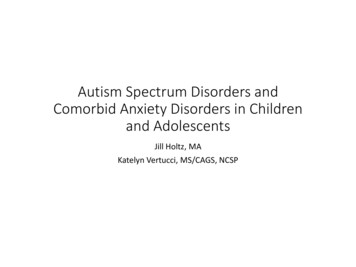
Transcription
Autism Spectrum Disorders andComorbid Anxiety Disorders in Childrenand AdolescentsJill Holtz, MAKatelyn Vertucci, MS/CAGS, NCSP
Disclosure The presenters have no financial relationship to this program.
Objectives Recognize the signs and symptoms of anxiety disorders in children withautism. Identify the components of a diagnostic assessment for comorbidanxiety disorders in children with autism. Incorporate evidence based interventions for treating comorbid anxietydisorders in children with autism. Empower children with autism to self-address symptoms of anxietyacross various settings.
What is Autism? A pervasive developmental disorder featuring deficits in socialcommunication and social interaction across contexts, as well as thepresence of restricted and repetitive patterns of behavior, interests, oractivitiesAmerican Psychiatric Association, 2013 Prevalence: 1 in 68 (CDC, 2014) Likely decrease to 1 in 100 based on DSM-5 criteria Highly heterogeneous group
DSM-5 ASD Diagnostic Criteria Deficits in social communication (3) Social approach/interaction Nonverbal communication Relationships Presence of restricted, repetitive patterns of behavior, interests, oractivities (2) Stereotyped or repetitive motor movements, objects, or speechRoutinesRestricted interestsSensory differences
How is Autism Diagnosed? Common Screening Tools M-CHAT-R, STAT SCQ “Gold Standard” diagnostic evaluations include: Developmental and medical historySpeech and language testingCognitive testingADOS-2 evaluation
ASD and hiatric
ASD and Anxiety 18% of individuals in the general population 40-80% of individuals with ASD (Autism Speaks) Many children with autism experience elevated levels of anxiety Not all anxiety is a disorder Associated with amplification of core symptoms of ASD, behavioralsymptoms (i.e., tantrums, aggression, and self-injury)
Characteristics of Anxiety Disorders Core features Excessive feelings of worry, fear, and/or avoidance Can be specific fears such as social situations or phobias or general feelingsof anxiety Can include obsessive compulsive disorders Autism-related associated features May show anxiety in social situations that inhibit functioning Ritualistic behaviors can become obsessive/compulsive Avoidance of certain situations due to sensory concerns
Types of Anxiety Disorders Specific Phobias (30%) Social Anxiety Disorder (17%) Obsessive-Compulsive Disorder* (17%) Separation Anxiety (9%) Generalized Anxiety Disorder (15%) Panic Disorder (2%)
When to Consider an Additional Diagnosis There are concerns beyond ASD diagnostic criteria Behavior is beyond expectations for developmental level Concerns cause significant impairment Child has not responded to simple behavioral interventions (i.e., addingstructure, routine) Changes in functioning/newly emergent anxiety Anticipatory worries, fears, and avoidances beyond in the momentemotion regulation and sensory challenges
Challenges in Diagnosis Masking Overshadowing Symptom overlap Differences in manifestation of anxiety Difficulty with self awareness of symptoms Choosing appropriate instruments Age, norming
Manifestations of Anxiety in ASD More likely to be associated with “acting out” behaviors (Evans et al.,2005) High prevalence of social anxiety and specific phobias OCD or Restricted/Repetitive Behaviors? Higher IQ higher risk for behavioral difficulties Anxiety around aspects of life requiring language, social interaction
Making a Comorbid Diagnosis Self, Parent, and Teacher Report Rating Scales CBLC, BASC-2, MASC-2, SCARED The SCARED is available at no cost at www.wpic.pitt.edu/research undertools and assessments, or at www.pediatricbipolar.pitt.edu underinstruments. Lower functioning children: Diagnostic Assessment for HandicappedIndividuals, 2nd Edition (DASH-II); DSM-IV Clinical interviewing Gather additional information from caregivers and teachers How is child functioning across settings?
Considerations in InformationGathering Measures are not normed on this population Symptoms may already be explained by ASD diagnosis What is the purpose of making the diagnosis? Benefit to the child
Remember: When to Consider anAdditional Diagnosis There are concerns beyond ASD diagnostic criteria Behavior is beyond expectations for developmental level Concerns cause significant impairment Child has not responded to simple behavioral interventions (i.e., addingstructure, routine) Changes in functioning/newly emergent anxiety Anticipatory worries, fears, and avoidances beyond in the momentemotion regulation and sensory challenges
Treatment Effectiveness of cognitive behavioraltherapy (CBT) for anxiety disorders inchildren and adolescents has beendemonstrated across multiple studiesand age groups (e.g., Albano & Kendall,2002; Compton et al., 2004).
CBT for Anxiety in Children
Modifications of CBT for Children andAdolescents with ASD Increasing affective education Increasing use of visual approaches Emphasizing behavioral aspects Incorporating special interests Increasing parent involvement(Green & Wood, 2013)
Increasing Affective Education Simplify and reinforce connections among physiological feelings,anxious thoughts, and anxiety-related behaviors Add additional practice in recognizing facial expressions relatedto anxiety Ex.: drawing individual emotions, creating a scrapbook for emotions withpictures that elicit the emotion for the client, using metaphor ofbecoming a scientist (Atwood, 2003; Green & Wood, 2013; Sofronoff et al., 2005).
Emphasize Use of Visual Approaches Drawing exercises Cartoons Videos Worksheets and multiplechoice lists(Green & Wood, 2013; Wood et al., 2009)
Increasing Behavioral InterventionComponents Increasing exposure component of treatment Coping Cat program 8 out of 16 sessions of exposure therapy ASD adaptation 12 out of 16 sessions of exposure therapy (Wood,Drahota, Sze, Har, et al., 2009) Practice using coping skills during process of in vivo exposure Parent involvement in ABC’s of behavior(Green & Wood, 2013)
Incorporating Special Interests Can increase participation and motivation Integrate special interests when teaching CBT concepts Relate coping strategies to special interest(Atwood, 2003; Green & Wood, 2013; Wood et al., 2009)
Increasing Parent Involvement Parent psychoeducation about ASD and risks for anxiety Parents as coaches Parent training(Green & Wood, 2013)
Treating Co-Occurring Difficulties in ASD Deficits in social skills, communication, and adaptive behavior canintensify anxiety Adaptions of CBT for anxiety can include social skills training: Learning to make eye contact Using appropriate tone of voice Maintaining a conversation Fear hierarchies that include steps toward making friends and self-helpskills(Green & Wood, 2013; White et al., 2009; Wood et al., 2009)
Evidence for CBT for Youth with ASDand Anxiety Behavioral Interventions for Anxiety in Children with Autism (BIACA) Modification of Building Confidence (Wood & McLeod, 2008) for youth withASD 16 weekly sessions, 90-min sessions – 30 min spent with child, 60 minutes withfamily Intervention components: psychoeducation, reward system, KICK plan,behavioral exposure, parent training, playdates, social coaching, schoolinvolvement Research support: (Drahata et al., 2011; Storch et al., 2013; Wood et al., 2009)
Additional Evidence for Modifications ofCBT for Youth with ASD and AnxietyAuthors (year)AdaptationChalfont et al. (2007)Program extended, more visual aids and worksheets, moreexposure, exposure as homework, simplified cognitive activitiesReaven et al. (2008)Token reinforcement, visual structure and routine, worksheets,made own movie, video modeling, parent participationScarpa & Reyes(2011)Shorter sessions, songs, stories, and activities, parent training,parent psychoeducation group, use of “toolbox” metaphor forcoping strategiesSofronoff et al. (2005)Wood, Drahota, Sze,Har, et al. (2009)Child as scientist/explorer, use of “toolbox” metaphor for copingstrategiesParent training, improving daily living skills, addressing social skillsat home, at school, in public, peer buddy and mentoring.
Questions?
References Albano, A. M., & Kendall, P. C. (2002). Cognitive behavioral therapy for children and adolescents withanxiety disorders: Clinical research advances. International Review of Psychiatry, 14, 129-134. Atwood, T. (2003). Framework for behavioral interventions. Child and Adolescent Psychiatric Clinics ofNorth America, 12, 65-86. Chalfant, A. M., Rapee, R., & Carroll, L. (2007). Treating anxiety disorders in children with highfunctioning autism spectrum disorders: A controlled trial. Journal of Autism and DevelopmentalDisorders, 37, 1842-1857. Compton, S. N., March, J. S., Brent, D., Albano, A. M., Weersing, V. R., & Curry, J. (2004). Cognitivebehavioral psychotherapy for anxiety and depressive disorders in children and adolescents: An evidencebased review. Journal of the American Academy of Child and Adolescent Psychiatry, 43(8), 930-959. Drahota, A., Wood, J. J., Sze, K. , & Van Dyke, M. (2011). Effects of cognitive behavioral therapy on dailyliving skills in children with high-functioning autism and concurrent anxiety disorders. Journal of Autismand Developmental Disorders, 41, 257-265. Green, S. A. & Wood, J. J. (2013). Cognitive behavioral therapy for anxiety disorders in youth with ASD:Emotional, adaptive, and social outcomes. In A. Scarpa, S. W. White, & T. Attwood (Eds). CBT forChildren and Adolescents with High-Functioning Autism Spectrum Disorders (pp. 73-96). New York, NY:Guilford Press.
References Reaven, J. A., Blakeley-Smith, A., Nichols, S., Dasari, M., Flanigan, E., & Hepburn, S. (2008). Cognitivebehavioral group treatment for anxiety symptoms in children with high-functioning autism spectrumdisorders: A pilot study. Focus on Autism and Other Developmental Disabilities, 24, 27-37. Scarpa, A., & Reyes, N. M. (2011). Improving emotion regulation with CBT in young children with highfunctioning autism spectrum disorders: A pilot study. Behavioral and Cognitive Psychotherapy, 39, 495500. Sofronoff, K., Attwood, T., & Hinton, S. (2005). A randomized controlled trial of a CBT intervention foranxiety in children with Asperger syndrome. Journal of Child Psychology and Psychiatry, 46, 1152-1160. White, S. W., Ollendick, T., Scahill, L., Oswald, D., & Albano, A. M. (2009). Preliminary efficacy of acognitive-behavioral treatment program for anxious youth with autism spectrum disorders. Journal ofAutism and Developmental Disorders, 39, 1652-1662. Wood, J. J., Drahota, A., Sze, K., Har, K., Chiu, A., & Langer, D. A. (2009). Cognitive behavioral therapy foranxiety in children with autism spectrum disorders: A randomized, controlled trial. Journal of ChildPsychology and Psychiatry, 50, 224-234. Wood, J. J., Drahota, A., Sze, K., Van Dyke, M., Decker, K., Fujii, C., et al. (2009). Brief report: Effects ofcognitive behavioral therapy on parent-reported autism symptoms in school-age children with highfunctioning autism. Journal of Autism and Developmental Disabilities, 39, 1608-1612.
cognitive behavioral therapy on parent-reported autism symptoms in school -age children with high- functioning autism. Journal of Autism and Developmental Disabilities, 39 , 1608-1612.
